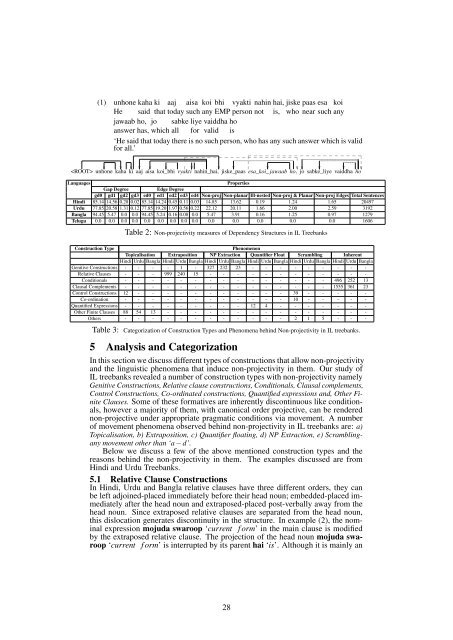A Treebank-based Investigation of IPP-triggering Verbs in Dutch
A Treebank-based Investigation of IPP-triggering Verbs in Dutch
A Treebank-based Investigation of IPP-triggering Verbs in Dutch
You also want an ePaper? Increase the reach of your titles
YUMPU automatically turns print PDFs into web optimized ePapers that Google loves.
(1) unhone kaha ki aaj aisa koi bhi vyakti nah<strong>in</strong> hai, jiske paas esa koi<br />
He said that today such any EMP person not is, who near such any<br />
jawaab ho, jo sabke liye vaiddha ho<br />
answer has, which all for valid is<br />
‘He said that today there is no such person, who has any such answer which is valid<br />
for all.’<br />
<br />
unhone<br />
kaha<br />
ki<br />
<br />
aaj<br />
<br />
aisa<br />
<br />
<br />
koi_bhi vyakti<br />
<br />
<br />
<br />
<br />
<br />
<br />
<br />
<br />
<br />
<br />
<br />
<br />
<br />
nah<strong>in</strong>_hai, jiske_paas esa_koi_ jawaab ho, jo <br />
sabke_liye vaiddha ho<br />
Languages<br />
Properties<br />
Gap Degree<br />
Edge Degree<br />
gd0 gd1 gd2 gd3 ed0 ed1 ed2 ed3 ed4 Non-proj Non-planar Ill-nested Non-proj & Planar Non-proj Edges Total Sentences<br />
H<strong>in</strong>di 85.14 14.56 0.28 0.02 85.14 14.24 0.45 0.11 0.03 14.85 13.62 0.19 1.24 1.65 20497<br />
Urdu 77.85 20.58 1.31 0.12 77.85 19.20 1.97 0.56 0.22 22.12 20.11 1.66 2.00 2.59 3192<br />
Bangla 94.45 5.47 0.0 0.0 94.45 5.24 0.16 0.08 0.0 5.47 3.91 0.16 1.25 0.97 1279<br />
Telugu 0.0 0.0 0.0 0.0 0.0 0.0 0.0 0.0 0.0 0.0 0.0 0.0 0.0 0.0 1606<br />
Table 2: Non-projectivity measures <strong>of</strong> Dependency Structures <strong>in</strong> IL <strong>Treebank</strong>s<br />
Construction Type<br />
Phenomenon<br />
Topicalisation Extraposition NP Extraction Quantifier Float Scrambl<strong>in</strong>g Inherent<br />
H<strong>in</strong>di Urdu Bangla H<strong>in</strong>di Urdu Bangla H<strong>in</strong>di Urdu Bangla H<strong>in</strong>di Urdu Bangla H<strong>in</strong>di Urdu Bangla H<strong>in</strong>di Urdu Bangla<br />
Genitive Constructions - - - - 1 - 327 232 23 - - - - - - - - -<br />
Relative Clauses - - - 999 240 15 - - - - - - - - - - - -<br />
Conditionals - - - - - - - - - - - - - - - 496 252 13<br />
Clausal Complements - - - - - - - - - - - - - - - 1555 361 23<br />
Control Constructions 12 - - - - - - - - - - - 39 - - - - -<br />
Co-ord<strong>in</strong>ation - - - - - - - - - - - - 10 - - - - -<br />
Quantified Expressions - - - - - - - - - 12 4 - - - - - - -<br />
Other F<strong>in</strong>ite Clauses 88 54 13 - - - - - - - - - - - - - - -<br />
Others - - - - - - - - - - - - 2 1 5 - - -<br />
Table 3: Categorization <strong>of</strong> Construction Types and Phenomena beh<strong>in</strong>d Non-projectivity <strong>in</strong> IL treebanks.<br />
5 Analysis and Categorization<br />
In this section we discuss different types <strong>of</strong> constructions that allow non-projectivity<br />
and the l<strong>in</strong>guistic phenomena that <strong>in</strong>duce non-projectivity <strong>in</strong> them. Our study <strong>of</strong><br />
IL treebanks revealed a number <strong>of</strong> construction types with non-projectivity namely<br />
Genitive Constructions, Relative clause constructions, Conditionals, Clausal complements,<br />
Control Constructions, Co-ord<strong>in</strong>ated constructions, Quantified expressions and, Other F<strong>in</strong>ite<br />
Clauses. Some <strong>of</strong> these formatives are <strong>in</strong>herently discont<strong>in</strong>uous like conditionals,<br />
however a majority <strong>of</strong> them, with canonical order projective, can be rendered<br />
non-projective under appropriate pragmatic conditions via movement. A number<br />
<strong>of</strong> movement phenomena observed beh<strong>in</strong>d non-projectivity <strong>in</strong> IL treebanks are: a)<br />
Topicalisation, b) Extraposition, c) Quantifier float<strong>in</strong>g, d) NP Extraction, e) Scrambl<strong>in</strong>gany<br />
movement other than ‘a − d’.<br />
Below we discuss a few <strong>of</strong> the above mentioned construction types and the<br />
reasons beh<strong>in</strong>d the non-projectivity <strong>in</strong> them. The examples discussed are from<br />
H<strong>in</strong>di and Urdu <strong>Treebank</strong>s.<br />
5.1 Relative Clause Constructions<br />
In H<strong>in</strong>di, Urdu and Bangla relative clauses have three different orders, they can<br />
be left adjo<strong>in</strong>ed-placed immediately before their head noun; embedded-placed immediately<br />
after the head noun and extraposed-placed post-verbally away from the<br />
head noun. S<strong>in</strong>ce extraposed relative clauses are separated from the head noun,<br />
this dislocation generates discont<strong>in</strong>uity <strong>in</strong> the structure. In example (2), the nom<strong>in</strong>al<br />
expression mojuda swaroop ‘current f orm’ <strong>in</strong> the ma<strong>in</strong> clause is modified<br />
by the extraposed relative clause. The projection <strong>of</strong> the head noun mojuda swaroop<br />
‘current f orm’ is <strong>in</strong>terrupted by its parent hai ‘is’. Although it is ma<strong>in</strong>ly an<br />
28
















